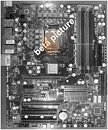- Joined
- Oct 9, 2007
- Messages
- 47,853 (7.39/day)
- Location
- Dublin, Ireland
| System Name | RBMK-1000 |
|---|---|
| Processor | AMD Ryzen 7 5700G |
| Motherboard | Gigabyte B550 AORUS Elite V2 |
| Cooling | DeepCool Gammax L240 V2 |
| Memory | 2x 16GB DDR4-3200 |
| Video Card(s) | Galax RTX 4070 Ti EX |
| Storage | Samsung 990 1TB |
| Display(s) | BenQ 1440p 60 Hz 27-inch |
| Case | Corsair Carbide 100R |
| Audio Device(s) | ASUS SupremeFX S1220A |
| Power Supply | Cooler Master MWE Gold 650W |
| Mouse | ASUS ROG Strix Impact |
| Keyboard | Gamdias Hermes E2 |
| Software | Windows 11 Pro |
MSI is working on its third motherboard that makes use of Lucid Hydra multi-GPU technology, this one aimed to be a more affordable model than the Big Bang Fuzion, for the socket LGA-1156 platform. Lucid Hydra technology allows users to mix and match graphics cards from across brands and models to upscale performance. A newly-release driver (1.5.106) for Hydra is said to increase functionality by adding full support for DirectX multi-GPU scaling, as well as expects significantly higher performance upscaling compared to older drivers. The new motherboard from MSI is the P55-GD88 Hydra, also to be known as P55A Hydra.
Built on a PCB that's different from that of the Big Bang Fuzion, the P55A Hydra uses High-C capacitors only for the CPU VRM, with normal solid-state capacitors for the rest of the board. Unlike the Big Bang Fuzion it has only two PCI-Express 2.0 x16 slots, but these slots work at x16 speeds. Perhaps the only selling point for Hydra on this setup (since Intel P55 platform already supports both SLI and CrossFire, and tests have shown performance hit between x16 and x8 to be insignificant for even high-end GPUs), is the ability to mix and match different kinds of graphics cards, including mixing an ATI Radeon card with an NVIDIA GeForce card.

Other features of the P55A Hydra include 10-phase CPU VRM, consolidated voltage measure points, two SATA 6 Gb/s ports apart from seven 3 Gb/s ones, USB 3.0, and connectivity which includes 8-channel audio, gigabit Ethernet, eSATA and FireWire. The MSI P55A could debut in a few weeks time, targeting a price point significantly lower than that of the Big Bang Fuzion.
View at TechPowerUp Main Site
Built on a PCB that's different from that of the Big Bang Fuzion, the P55A Hydra uses High-C capacitors only for the CPU VRM, with normal solid-state capacitors for the rest of the board. Unlike the Big Bang Fuzion it has only two PCI-Express 2.0 x16 slots, but these slots work at x16 speeds. Perhaps the only selling point for Hydra on this setup (since Intel P55 platform already supports both SLI and CrossFire, and tests have shown performance hit between x16 and x8 to be insignificant for even high-end GPUs), is the ability to mix and match different kinds of graphics cards, including mixing an ATI Radeon card with an NVIDIA GeForce card.

Other features of the P55A Hydra include 10-phase CPU VRM, consolidated voltage measure points, two SATA 6 Gb/s ports apart from seven 3 Gb/s ones, USB 3.0, and connectivity which includes 8-channel audio, gigabit Ethernet, eSATA and FireWire. The MSI P55A could debut in a few weeks time, targeting a price point significantly lower than that of the Big Bang Fuzion.
View at TechPowerUp Main Site
Last edited:






